Peter MALONE
Saturday, 18 September 2021 19:57
Doctor, You've Got to be Kidding
DOCTOR, YOU'VE GOT TO BE KIDDING
US, 1966, 94 minutes, Colour.
Sandra Dee, George Hamilton, Celeste Holm, Bill Bixby, Dwayne Hickman, Dick Kallman, Mort Sahl, Allen Jenkins.
Directed by Peter Tewkesbury.
Doctor, You’ve Got to be Kidding is a lightweight comedy with the songs from the mid-1960s, the kind of fluffy film for a teenage audience in the vein of Where The Boys Are, Looking for Love…
It is a star vehicle for Sandra Dee, in her mid-20s but having been on screen for almost a decade, appearing in some substantial films as well as being Gidget and Tammy. She became very popular in such films as A Summer Place, and was married to Bobby Darrin for some years. Ironically, for the plot of this film, she had a very determined and show business mother who wanted her daughter to succeed.
The film is also a vehicle for George Hamilton, appearing as a businessman with a very high IQ, photographic memory, attention span on several issues at once or, as Sandra Dee refers to him, a stuffed shirt.
The screenplay of the film reflects the change in moral attitudes at the period. The film opens with a pregnant Sandra Dee going to the hospital accompanied by three potential fathers (a theme later used in Mamma Mia). The film goes into flashback, Heather as a little girl, being forced to sing for agents by her elevator-driving mother, Celeste Holm, and then finally growing up and still being forced, against her will, to a musical career.
However, she goes to College (four wasted years according to her mother) and gets a job as a secretary, very efficient, to George Hamilton. She asks his opinion about her voice and after listening to two or three words, he condemns it. Which makes her more determined, her mother getting a loan for $5000 to pay for lessons, clothes, and organises her into a club. But she fails to turn up because she has fallen in love with the boss and spends the night with him – leading to the pregnancy.
The film spends a lot of time on her three suitors, Hank (Dwayne Hickman), a shoe salesman and would-be actor who specialises in death scenes, Dick Kallman as her singing teacher and Bill Bixby (before The Incredible Hulk) as the next door neighbour.
Celeste Holm, an Oscar for the Best Supporting Actress in Gentleman’s Agreement in 1947, often a wise-cracking associate, in High Society, 1957, enjoys herself as the archetypal show business and pressurising mother. But the best and funny lines come from comedian, Mort Sahl, as the owner of the club who dislikes modern music and is not afraid to express himself, quite sardonically, about the contemporary trends.
While Heather begins the film as a Sandra Dee type, she has some moments of rebellion as well as moving into 1960s costumes and singing and dancing (and gyrating) style – which looks like an imitation of Ann- Margret in her films of that period.
Absolute fluff, popular in its time, probably seeming dated to younger audiences, but an indication of this kind of film in the 1960s.
US, 1966, 94 minutes, Colour.
Sandra Dee, George Hamilton, Celeste Holm, Bill Bixby, Dwayne Hickman, Dick Kallman, Mort Sahl, Allen Jenkins.
Directed by Peter Tewkesbury.
Doctor, You’ve Got to be Kidding is a lightweight comedy with the songs from the mid-1960s, the kind of fluffy film for a teenage audience in the vein of Where The Boys Are, Looking for Love…
It is a star vehicle for Sandra Dee, in her mid-20s but having been on screen for almost a decade, appearing in some substantial films as well as being Gidget and Tammy. She became very popular in such films as A Summer Place, and was married to Bobby Darrin for some years. Ironically, for the plot of this film, she had a very determined and show business mother who wanted her daughter to succeed.
The film is also a vehicle for George Hamilton, appearing as a businessman with a very high IQ, photographic memory, attention span on several issues at once or, as Sandra Dee refers to him, a stuffed shirt.
The screenplay of the film reflects the change in moral attitudes at the period. The film opens with a pregnant Sandra Dee going to the hospital accompanied by three potential fathers (a theme later used in Mamma Mia). The film goes into flashback, Heather as a little girl, being forced to sing for agents by her elevator-driving mother, Celeste Holm, and then finally growing up and still being forced, against her will, to a musical career.
However, she goes to College (four wasted years according to her mother) and gets a job as a secretary, very efficient, to George Hamilton. She asks his opinion about her voice and after listening to two or three words, he condemns it. Which makes her more determined, her mother getting a loan for $5000 to pay for lessons, clothes, and organises her into a club. But she fails to turn up because she has fallen in love with the boss and spends the night with him – leading to the pregnancy.
The film spends a lot of time on her three suitors, Hank (Dwayne Hickman), a shoe salesman and would-be actor who specialises in death scenes, Dick Kallman as her singing teacher and Bill Bixby (before The Incredible Hulk) as the next door neighbour.
Celeste Holm, an Oscar for the Best Supporting Actress in Gentleman’s Agreement in 1947, often a wise-cracking associate, in High Society, 1957, enjoys herself as the archetypal show business and pressurising mother. But the best and funny lines come from comedian, Mort Sahl, as the owner of the club who dislikes modern music and is not afraid to express himself, quite sardonically, about the contemporary trends.
While Heather begins the film as a Sandra Dee type, she has some moments of rebellion as well as moving into 1960s costumes and singing and dancing (and gyrating) style – which looks like an imitation of Ann- Margret in her films of that period.
Absolute fluff, popular in its time, probably seeming dated to younger audiences, but an indication of this kind of film in the 1960s.
Published in Movie Reviews
Published in
Movie Reviews
Tagged under
Saturday, 18 September 2021 19:57
Free Soul, A
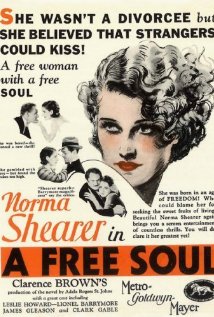
A FREE SOUL
US, 1931, 93 minutes, Black and white.
Norma Shearer, Leslie Howard, Lionel Barrymore, Clark Gable, James Gleason, Lucy Beaumont.
Directed by Clarence Brown.
A Free Soul was one of the notable films from 1931, Lionel Barrymore winning an Oscar for Best Actor and Norma Shearer, who won the Oscar the year before for The Divorcee, also nominated. The film was directed by Clarence Brown, one of the distinguished directors at MGM, a favourite for Greta Garbo, making many polished films in 1930s and 40s, as well as The Yearling and National Velvet in the 1940s.
This is a story of a wilful young woman played by Norma Shearer. Her mother had died in childbirth and she has been brought up by her lawyer father, a workaholic with a severe drinking problem, his own father having finished up in an insane asylum. He had fostered her independence and free spirit. They come from a wealthy and snobbish family, and she is engaged to an English polo player, played by Leslie Howard (who was to act with Norma Shearer in Romeo and Juliet).
The film opens with the lawyer winning the freedom of an accused murderer and gambler, played with very steady aplomb by Clark Gable. The young woman becomes infatuated with the gambler, beginning an affair with him, to the desperation of her fiance, to the disgust of her father. She makes a bargain with him that she will give up the gambler if he gives up the drink – and they go for several weeks into the Rockies, accompanied by the lawyer’s assistant, played by James Gleason. They are successful for some time, but, ultimately, the lawyer goes on the drink again, and the young woman is rejected by her family.
She goes again to the gambler but he makes demands on her, as well as on her fiance. There is a melodramatic development when the fiance goes to the gambler’s office and shoots him. The lawyer then defends the young man, bringing his daughter to the witness box, going through her life, ultimately blaming himself for her life and for the situation leading the young man to shoot the gambler. And then he collapses.
Lionel Barrymore, a star at MGM for the next 20 plus years, ultimately confined to a wheelchair which did not confine his career, gives a tour de force performance.
1. A prestige film of 1931? MGM production values? San Francisco settings, the Rockies (in the studio)? The court, prison, gambling casinos in the age of prohibition, mansions, the outdoors? The musical score? The cast?
2. The focus on Stephen Ashe, Lionel Barrymore’s presence and performance, Oscar-winning? The background story, his alienation from his mother, her disapproval of his drinking? Avoiding her, having to go to the birthday party, arriving drunk, with Ace, the confrontations? His performance in court, his having fallen on hard times, the evidence of the hat for the gambler, putting it on the gambler’s head and its not fitting, the gambler’s release? Seeming friendship with the gambler, going to his club, later turning against him, calling him a mongrel, disapproving of his daughter’s relationship with him after the shock of discovering her there? His love for his daughter, fostering her free spirit? His shock at her affair? Her bargain, his going off the drink, consenting, going out into the mountains, with his friend Eddie who supplied him with liquor, his inability to sleep, going on the drink again? His collapse?
3. Jan, the free soul, the death of her mother, her snobbish family, love for her grandmother, the visit for the birthday, her devotion to provide, Dwight, his proposal, the possibility for a marriage, yet her wanting to be free? The initial meeting with Ace, the attraction, the aftermath of the case, going to him, the affair, her moving in, her drunken father discovering her presence? The deal, his going off the drink, her giving up Ace? In the mountains, the note, the tearing it up? Her father’s relapse? Her going to Ace? His wanting to marry her, his rough stances, rid of his previous mistress, the confrontation, the attempted kiss, her leaving, Dwight and his arrival, hearing Ace’s threats?
4. Dwight, British, polo player, in love with Jan, the proposal, his accepting her relationship with Ace, going to see her, hearing the threats? His going to Ace, shooting him? Confessing? Prison, Jan’s visit? In the court, not wanting a trial, not wanting Stephen to defend him, not wanting Jan in the witness box? His desperation in listening?
5. Ace, mob, corrupt, drugs, drink, white slavery, his staff, the club, his confidence, changing tie for Jan’s colour, in court, the hat, getting off, coming with Stephen to the family dinner, their humiliating him? His relationship with Jan, love, the disappearance, return, his demands, violent threats, his death?
6. Eddie, the faithful friend, supplying the drink, support, love for Jan?
7. The grandmother, her age, the party, regrets about her son, love for Jan, her dying, Dwight with her, the family preventing Jan visiting her? Dwight bringing her to her grandmother?
8. The background of the legal system, the court cases, the prosecutors, juries, the judges, the speeches by the defence lawyers?
9. The more permissive scenario in the film made before the introduction of the Motion Picture Code?
Published in Movie Reviews
Published in
Movie Reviews
Tagged under
Saturday, 18 September 2021 19:57
Man from U.N.C.L.E., The
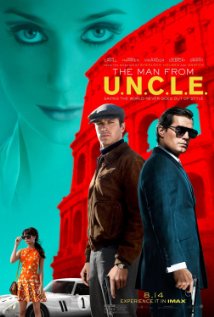
THE MAN FROM UNCLE
US, 2015, 116 minutes, Colour.
Henry Cavill, Armie Hammer, Alicia Vikander, Elizabeth Debicki, Hugh Grant, Jared Harris.
Directed by Guy Ritchie.
Way back when, or way way back when, depending on how old you are or how old you admit to being, there were many Bondish spy stories on the big screen and on television, including Napoleon Solo and his Russian ally, Ilya Kuriakin, in the forms of Robert Vaughn and David Mc Callum. It is half a century later and, of course, in this age of superheroes, we have their new incarnations, Henry Cavill who was the new Superman and Armie Hammer who was the Lone Ranger.
The film was directed by Guy Ritchie who has a flair for action, with his initial Lock, Stock and Two Smoking Barrels, his gangster films like Revolver and Rock‘n rolla, and with his breakthrough films about Sherlock Holmes, with Robert Downey Jr and Jude Law. He brings something of this flair for action, verve and colour to this re-booting of The Man from U.N.C.L.E.
.
The initial television series setting is retained. We are in the early 1960s.There is quite an elaborate collage during the initial credits giving something of a history lesson visually, clips and glimpses of the war, post-war Europe, the Iron Curtain, the Cold War, nuclear fears, President John F.Kennedy. And, in the middle of the film, there is another collage taking us back to Nazi Germany, the development of weapons, the development of torture.
Napoleon Solo and Ilya Kuriakin are presented as agent icons. And it will depend on your opinion of them as screen presences, good-looking heroes – and, as a reviewer smartly noticed, different in ideologies but united in square jaws! Henry Cavill portrays Napoleon Solo as something of a Christopher Reeve- Clark Kent, his performance in the 2012 Man of Steel. His humour is very dry, and his emotional display is kept very much under control (or is not there in the first place). He seems tall by himself at six feet one, but is rather dwarfed by Armie Hammer at six feet four! And Hammer has the showier role, single-minded in his loyalties, prone to anger at having to pretend to be calm as he poses as the fiance of Gabby, (Alicia Vikander, A Royal Wedding, Ex Machina, Son of a Gun, Testament of Youth) who Is the daughter of a nuclear scientist, used by the Nazis, at work in the US, abducted by a powerful wealthy Italian couple who are getting him to develop a nuclear bomb for their clients.
There are all kinds of action sequences, the two getting into all kinds of trouble, even Napoleon experiencing torture, but each emerging relatively unscathed.
Elizabeth Denicki (Australian actor from The Great Gatsby) is a tall, slinky, arrogant villain. But there is counterbalance in the perennial stiff-upper-lip British controller, played by Hugh Grant in his ineffable way, still in the For Weddings and a Funeral mode two decades later!
This is a reasonably enjoyable show, good to look at, not particularly memorable, but an insertion into the Cold War past – and with the prospect of a sequel!
1. The popularity of the original series? The 1960s? 50 years later, the 21st century? The Cold War, the US and the Soviet Union, the hypothesis of collaboration, nuclear fears? The film version keeping the past situations?
2. Post-war America, the Soviet Union, Berlin and the wall? The collage of events for the credits, from the 1940s to the 1960s, the war, Cold War, JF Kennedy, Kruschev? The detail? The later collage of Hitler, weapons?
3. Agents, on both sides of the divide, the plot, action, stunts, special effects?
4. The introduction to Napoleon Solo, his story, the war, art, theft, prison? The authorities seeing him as an expert agent? The introduction to Kuryakin? In East Berlin? Tailing Napoleon, thwarting the action? The extraction of Gaby, Napoleon going to the garage, the discussions about her father, the proposal, her taking a stand, the chase throughout East Berlin, coming to the wall, the guards, the link, Kuryakin and his pursuit? Being thwarted? The wire, getting Gaby out, into the vehicle?
5. Kuryakin a Russian agent, his reputation, the pursuit, devices, driving skills, his defeat? His ideology? Anger? Relationship with his controller?
6. Henry Cavill, Armie Hammer as strong, square-jawed types? Iconic – and stereotypes? The contrast with the presentation of the women as fuller characters?
7. The nuclear situation, the US, Teller, his work for Nazi Germany, the Soviet interest? The Italians, their clients, wanting the bomb? The wealth, facilities, means of transport?
8. The Italian settings, Rome, the city, lavish, the mansion? Action on land, action in the water?
9. Gaby as the centre, to meet her father again, her work in the garage, being transformed and glamorous, Kuryakin meant to be with her, the couple, his brusque manner, courting her, the comic touches with fashion, his anger, those in pursuit, his outbursts, having to give way, the boat chase? His being with the thugs – and private revenge? His private behaviour?
10. Napoleon, his controller, the US and the UK, the Soviet Union, the connections, Victoria and her presence, her husband, the relationship, freewheeling?
11. Victoria, tall, wealthy, ruthless, her husband, sexual predator, violence? Her husband, her dominance, the racing cars, the driving, his angers?
12. The two men in the hotel, the contacts, suspicions? Gaby’s Uncle Rudi? Science, his capacity for torture, relishing it? Torturing Napoleon? The reverse – and his being tortured, ready to admit everything, his death?
13. Teller, the Nazis, in the US, Soviet interest, his capacities for making a nuclear device, his trying to deceive Victoria with the lens, reunited with Gaby, Victoria controlling him, fixing the bomb? His death?
14. Hugh Grant as the British controller, his interventions, his speech, delivery, suave? With each of the agents? With Gaby? The irony of the truth about Gaby and her being a British agent? Leading Napoleon and Kuryakin on?
15. The bomb, the boat, the ability to locate the bomb, sending missiles? Victoria, the arrogance, her death? Her husband’s death? Napoleon and his touch of arrogance, escape?
16. Each of the agents given the mission to kill each other, the situations, the possibilities for killing each other, confrontation, survival – and British control
giving the title U.N.C.L.E.?
Published in Movie Reviews
Published in
Movie Reviews
Tagged under
Saturday, 18 September 2021 19:57
Saint's Double Trouble, The
THE SAINT'S DOUBLE TROUBLE
US, 1940, 67 minutes, black and white.
George Sanders, Helene Reynolds, Jonathan Hale, Bela Lugosi, Donald Mac Bride.
Directed by Jack Hively.
The double trouble for the Saint is that there is a double called The Boss, who bears an absolute resemblance to George Sanders – and, of course, is played by George Sanders, slightly making his dignified voice rather low key for The Boss. And The Boss wants to get rid of The Saint, favouring framing him for various crimes, jewel robberies and murders – and leaving a characteristic note with the initials ST and the cartoon drawing of The Saint. It is explained in screenplay that the real Saint has little tattoo on his wrist – and while some of the characters see it, the audience doesn’t, and it is very, very difficult at times to tell who is who.
The basic plot is that Simon Templar has sent a mummy to his professor in Philadelphia but jewel thieves have noted the address and concealed diamonds be smuggled in the mummy.
The professor in Philadelphia is delighted, but becomes the victim of The Boss. The professor’s daughter has the huff about her treatment previously by the Saint, its being dismissive. But, he has a soft spot for her, rescues her from the criminals and from a watery grave and she says at the end, “Long Leave the Saint”.
In the meantime, The Boss intercepts some of Simon Templars notes and vice versa, confusing The Boss, The Dutchman (Bela Lugosi in a slight role) as well as the police, the local chief and Simon Templar’s friend from the past, Inspector Henry Ferneck.
The Saint has to rectify the situations created by The Boss – sometimes jumping on to the back of the car, sometimes being tied up and tortured, and another time being tied up and sailing on the harbour when one of the crooks, Limpy, has been shot and he unties himself just in time!
There is a complication for us all, when Simon Templars sets up The Boss in the prison cell and uses Saint’s female disguise to escape – but Templar had warned that this was going to happen and so The Boss is shot in his stead.
Not a particularly startling example of this series with George Sanders.
US, 1940, 67 minutes, black and white.
George Sanders, Helene Reynolds, Jonathan Hale, Bela Lugosi, Donald Mac Bride.
Directed by Jack Hively.
The double trouble for the Saint is that there is a double called The Boss, who bears an absolute resemblance to George Sanders – and, of course, is played by George Sanders, slightly making his dignified voice rather low key for The Boss. And The Boss wants to get rid of The Saint, favouring framing him for various crimes, jewel robberies and murders – and leaving a characteristic note with the initials ST and the cartoon drawing of The Saint. It is explained in screenplay that the real Saint has little tattoo on his wrist – and while some of the characters see it, the audience doesn’t, and it is very, very difficult at times to tell who is who.
The basic plot is that Simon Templar has sent a mummy to his professor in Philadelphia but jewel thieves have noted the address and concealed diamonds be smuggled in the mummy.
The professor in Philadelphia is delighted, but becomes the victim of The Boss. The professor’s daughter has the huff about her treatment previously by the Saint, its being dismissive. But, he has a soft spot for her, rescues her from the criminals and from a watery grave and she says at the end, “Long Leave the Saint”.
In the meantime, The Boss intercepts some of Simon Templars notes and vice versa, confusing The Boss, The Dutchman (Bela Lugosi in a slight role) as well as the police, the local chief and Simon Templar’s friend from the past, Inspector Henry Ferneck.
The Saint has to rectify the situations created by The Boss – sometimes jumping on to the back of the car, sometimes being tied up and tortured, and another time being tied up and sailing on the harbour when one of the crooks, Limpy, has been shot and he unties himself just in time!
There is a complication for us all, when Simon Templars sets up The Boss in the prison cell and uses Saint’s female disguise to escape – but Templar had warned that this was going to happen and so The Boss is shot in his stead.
Not a particularly startling example of this series with George Sanders.
Published in Movie Reviews
Published in
Movie Reviews
Tagged under
Saturday, 18 September 2021 19:57
Are You LIstening?
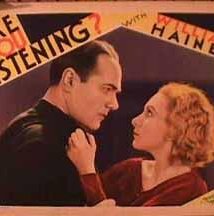
ARE YOU LISTENING?
US, 1932, 72 minutes, black and white.
William Haines, Madge Evans, Anita Page, Karen Morley, Neil Hamilton, Wallace Ford, Jean Hersholt, Joan Marsh.
Directed by Harry Beaumont.
Are You Listening? is a drama set in the early days of popular radio. It is definitely a pre-Code film, with the central character involved in a relationship outside his marriage, wanting a divorce, but married to a demanding woman who refuses to let him go. In the middle of the film, he has an argument with her, pushing her away and her hitting some furniture and dying. He becomes confused, goes to see his mistress, escapes from New York with her, travelling by car to Florida.
He has been a successful radio station personality and food shows in some detail about the way programs were made, the time pressures, emotions, scripts, exasperation with sponsors and trying to get them interested while they want their product named at any cost, actors and producers, crooners, the sound-effects man and his successes and failures with wind, avalanches…
The girlfriend, a really pleasant young woman, works at the radio station as does her younger sister as a receptionist – but who prefers the all-night clubbing life. The youngest sister also comes to town and both are concerned at the death and the escape of the couple.
One of the main themes is that the newspaper in New York which has a relationship with the radio decides to collaborate with the police. The difficulty is that the editor, Neil Hamilton, is an exploiter and his sensational words on the radio are extremely prejudiced and judgemental. An editor in Florida contacts New York so that both the voices are heard, edited, on the radio, especially with the girlfriend pleading innocence.
New York exploits this and police come, both couples are arrested, the girl set free, and goes to see a lawyer, while the man sentenced to 3 years for manslaughter and manfully goes to jail, hoping for remission of time for good conduct.
The film was directed by Harry Beaumont, a director from silent times and director of the Oscar winning Broadway Melody as well as several of the Maisie series.
Published in Movie Reviews
Published in
Movie Reviews
Tagged under
Saturday, 18 September 2021 19:57
Blessed Event
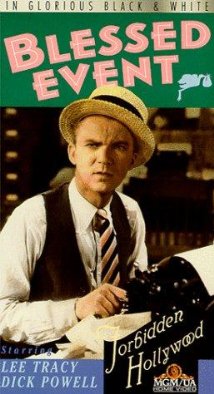
BLESSED EVENT
US, 1932, 80 minutes, Black-and-white.
Lee Tracy, Mary Bryant, Dick Powell, Allen Jenkins, Ruth Donnelly, Emma Dunn, Edwin Maxwell, Ned Sparks, Frank Mc Hugh.
Directed by Roy Dell Ruth.
Blessed Event is an entertaining film of the early 1930s, rather in the vein of classic, The Front Page.
This time the film is set in the office of a magazine, prone to have scandal articles, upping the sales, investigations into the life of celebrities – and especially suggesting pregnancies and blessed events.
Lee Tracy was famous for his rapid-fire delivery of his lines. This is to the fore in this film, he playing a reporter who capitalises on embarrassing events, is unscrupulous in using people, even when he has promised not to. This is a film to see Lee Tracy at his most characteristic and best.
Ruth Donnelly is very good, especially in her sardonic delivery, as his assistant at the magazine. Allen Jenkins is a rather dumb hitman, sent by an antagonistic gangster – but Tracy converts the hitman so that he becomes an informant for him. He also the discovers that the young woman who has come to plead mercy and her story not to be told and she is pregnant because of the gangster.
There are some amusing scenes when Allen Jenkins visits Tracy’s mother, gets into a conversation and she thinks he is most respectable. She is also a radio fan of the crooner who sings at the club and also on radio singing commercials – antagonistic towards Tracy who is out to get him, especially at the opening of a new club. The singer is played by Dick Powell.
The film is fast paced, builds up to a climax when Tracy infiltrates the club, the gangster is present, the crooner thinks that Tracy will not get in, and eventual the woman arrives and there is a shooting.
1. Film of the 1930s? Newspapers and magazines? Reporters? Quick Talking characters, the piece of the action?
2. Black-and-white photography, the American city, offices, homes and apartments, the world of the gangsters, restaurants and clubs?
3. The cast, Lee Tracy and pace of his delivery, screen presence? Did all and his songs? Ruth Donnelly and her chronic presence and patter?
4. The title, the column, the insinuations about pregnancy, gossip, People’s reputations secrecy? The journalist not hearing? The different cases, the revelations? The secretary and her support?
5. His assistant, the repartee, quick retorts, doing the job, his jobs? The bosses and their stances?
6. Gangsters, threats, Jenkins and here’s presence, confrontation,, municipal of information, winning the journalist? The visit with the journalists mother and friendly welcome?
7. The journalist, vehicle, the different promises, instantly breaking?
8. Ready of the period, the studios, the extensive commercials? The sooner and his role with the commercials? The songs? The women in the audience, their adoration? The reporters mother and her son? The threats, the challenge for the journalist and the club, the extreme security – and is getting a?
9. The young woman, coming to appeal to him, offering his help, lies, printing the story, her being upset, wanting to home, her parents, her show? Are’s treatment? The journalist discovering the gangster was the father? Getting help, the explosion, the confrontation?
10. The club, and Jenkins and the women, getting in, the owner not realising it, the journalist talking, the smooth talk, the similar, the express the and the shooting?
11. Brief, brash?
Published in Movie Reviews
Published in
Movie Reviews
Tagged under
Saturday, 18 September 2021 19:57
Chronic

CHRONIC
US/Mexico, 2015, 93 minutes, Colour.
Tim Roth, Robin Bartlett, Michael Christofer, Sarah Sutherland, Rachel Pickup.
Directed by Michel Franco.
Chronic won the screenplay award at the Cannes film Festival in 2015. It was written by the director, Mexican, Michel Franco. He brings a Hispanic perspective to his California story.
The focus of the film is a skilled nurse, played by Tim Roth. We see him tending a sick woman, Sarah, carefully washing her, dressing her, preparing her for the visit of her family. He tends to identify with her and the family. After her funeral, he takes on another patient, John, an architect played by Michael Christofer, playwright and screenwriter. John is cantankerous, but enjoys David’s company and care, ousting his own family. He is an architect and David goes to see some of his homes, passing himself off as an architect. John watches pornography on his computer and when a nephew sees David washing his uncle, he objects and the family sues David for sexual harassment.
When David loses his job, he goes to see the head of the agency and takes on a new patient, an older woman who is undergoing chemotherapy. They become friends, he cleaning her in embarrassing situations, when she soils herself, and she comes to rely on him but wanting him to assist her in her death. When he declines, she sends him away.
In the meantime, the audience learns more about David, his family, the death of his child, his work as a nurse – and then there is a sudden and shocking ending which precludes any speculation about the future.
1. An American story, California story? The director, Mexico and his perspective? Hispanic? The screenplay award at Cannes?
2. Los Angeles, homes, hospitals, the streets, jogging, the gym…? The musical score?
3. The single static shots, long, no movement except for the driving and for jogging? The static and contemplative effect?
4. David, his character, gradually revealed, his wife, his child, disability, care, the death? Divorce? Nadia, the friendship, the Facebook search and her photos? Her re-appearance and renewing friendship with David?
5. David, his nursing skills, work for the agency, the detail of his washing and tending to Sarah, her personality, passive, ill, response, the relatives and their visit, the funeral, his identifying with the family? The woman offering him a lift and asking questions?
6. John as a patient, his background as an architect, the stroke, David and his visit, care for John, John and cantankerous with his wife, the family, ousting them? Watching pornography on his computer? David and his fidelity, Sylvia and her nightshift, the substitute, David wanting to stay the night? Watching television with David? The reaction of the family? The nephew coming in when David was washing John, private parts, his reaction? The attack and sexual harassment? David visiting the home, not being welcome?
7. David identifying with the architecture, going to the bookshop, getting the books, going to visit the house, quoting John’s description of the houses, his tool?
8. Going back to the agency, the discussions with Oscar, meeting Martha, offering to work for her?
9. Martha, her personality, age, adult children? The tests, illness, the treatment? The friendship with Martha, the care, soiling herself, the shower? Her request that he assist in her death, his refusal, her anger, sending him away?
10. David, reconnecting with the past, wife, discussions, Nadia?
11. The question of David’s future, possibilities – and the shock ending of the crash and his death?
Published in Movie Reviews
Published in
Movie Reviews
Tagged under
Saturday, 18 September 2021 19:57
Our Dancing Daughters
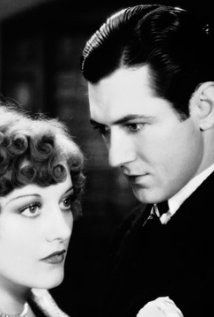
OUR DANCING DAUGHTERS
US, 1928, 85 minutes, Black and white.
Joan Crawford, John Mack Brown, Nils Asther, Dorothy Sebastian, Anita Page, Dorothy Cumming, Kathlyn Williams, Edward J.Nugent.
Directed by Harry Beaumont.
Our Dancing Daughters was one of the last silent films made by MGM, released in 1928. Joan Crawford had made a number of silent films but, this time, her name appeared above the title, and she began to emerge as a top star, a position she held for the next four decades, winning an Oscar in 1945 for Mildred Pierce.
The focus is on New York high society, prior to the 1929 crash on Wall Street. The wealthy young women seem to be ditzy types, flappers, out for a good time. And Joan Crawford as Diana, seems to be the wildest of all, enjoying going out, well-bonded with her parents, just enjoying a good time.
But, basically she is a good girl. This is in contrast to her friend Ann, Anita Page, who seems perfect on the outside but is an unscrupulous golddigger on the inside, something fostered by her mother, Kathlyn Williams.
When a wealthy young man comes to town, friend of the other men because of his college days and his skill in sports – Johnny Mack Brown – Diana becomes intrigued, but he suspects her of being too loose. In the background is Beatrice, Diana’s sister, and her fiance – a touch moody times, and resentful of the actresses rather wild men friends – played by Nils Asther. Then there is the playboy Freddie who is the man about town.
Ann becomes unhappy and board in her marriage, sets her sights on Freddie. The estrangement grows. Diana, in the meantime, regretting her reputation, still in love with the wealthy sportsmen, and he attracted always to her, goes to Europe for two years. On her return, the marriage has collapsed, Ann leading a reckless life which leads to her death. And, a happy ending for Diana.
This film was made before the Motion Picture Code and shows a rather wild lifestyle and some profligate behaviour – something that would be eliminated soon by the introduction of the Code.
Direction is by Harry Beaumont who directed the Oscar-winning Broadway Melody, a number of small films, especially those in the Maisie series with Ann Sothern.
Published in Movie Reviews
Published in
Movie Reviews
Tagged under
Saturday, 18 September 2021 19:57
End of the Tour, The
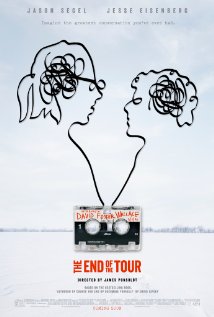
THE END OF THE TOUR
US, 2015, 106 minutes, Colour.
Jesse Eisenberg, Jason Segel, Anna Chlumsky, Joan Cusack, Mickey Sumner, Mamie Gummer, Ron Stevenson.
Directed by James Pondsolt.
The End of the Tour is something of a specialist film, a film for lovers of literary fiction, especially American fiction. it is basically a two-hander, several days of conversation between the novelist, David Foster Wallace, and a Rolling Stones reporter, David Lipsky, who accompanied him on part of his tour to promote his book, Infinite Jest, published in 1996. It is based on the reporter’s memoir, Although of Course You End up Becoming Yourself.
It does not matter if the audience has not heard of David Foster Wallace. They will have quite an impression of him by the end of the film. It does begin somewhat grimly, with the news in 2008 that he had killed himself. The reporter, David Lipski, is shocked to discover the news and prepares a eulogy of the novelist which he delivers in New York City.
Then the film goes into flashback.
Jesse Eisenberg, who is almost always the same in every film (well, always the same) whether he be Mark Zuckerberg in The Social Network or David Lipski – always a little hunch-shouldered and forward-stooping, nervous manner in speaking, always on the edge even when he is relaxed. But this suits him here, a reporter tired of writing about Boy Bands, and proposing to its editor that there is a story in the success of David Foster Wallace and his thousand page novel.
For those familiar with Jason Segel’s career, almost always in comedies, including Knocked up and similar comedies, Gulliver’s Travels and The Muppets, his performance here as Wallace will be a complete surprise – except that he does remind us that earlier in his career, it would be Jeff Daniels as Wallace. some commentators have said that he captures Wallace’s manner very well, a tall and rather lumbering man, always wearing a bandanna, chunks of hair emerging from each side of it, in old clothes (Joan Cusack’s chauffeur in Minneapolis exclaiming rhetorically as he goes to radio interview, “you’re not wearing that”). And, he doesn’t mind McDonald’s? and other takeaway food…
David Lipski goes to Bloomington to do the interview, recorded but Wallace has a few reservations, especially about the privacy of his parents. What follows is a great deal of conversation, relishing of words and delivery, interactions between the two men, Wallace speaking at a book signing, on radio, with a friend from university days (Mickey Sumner) and enthusiastic fan (Mamie Gummer).
There is a great deal of self-revelation from the two men, the reporter nosing out details for his story, but, somewhat envious of the writer, who does not take himself too seriously with his fame, who has a certain charm, despite living alone with his large dogs, friendly with students in his creative writing course, able to reflect on the themes of his work, especially the theme of loneliness and a future prospect for marriage and having children.
Direction is by James Ponsoldt whose work includes specialist films, Smashed and The Spectacular Now.
Words, words, words, – those who enjoy conversation will not be sick of words but will relish the conversations.
1. David Foster Wallace, his life and career, publication, his death? The film of literary interest? American fiction? Rolling Stone, reporting? The film based on David Lipsky’s memoir, the words of David Foster Wallace?
2. The perspectives of David Lipsky, his book, interest, interview, writing the book, news of Foster’s death, his eulogy?
3. A New York story, Rolling Stone and its office, editor? Apartments? The New York eulogy? The musical score?
4. Bloomington, the snow, the landscapes, winter, Wallace’s house, the interiors, the different rooms and contents? Reports, Minneapolis, the book signing, the radio station, the Mall of America, the movie theatre, homes?
5. Jesse Eisenberg as David Lipski? His age, career, his novel and articles, working with Rolling Stone? With Sarah, reading Wallace’s book, going to the editor, the plea, having to find a story? Going to Bloomington, the winter, lost, phoning Wallace, the meeting, permission to record, going to his creative writing class and watching him with the students, the discussions, his listening, taking notes, the discussion about the Alanis Morisette poster, Wallace and his restrictions and his agreeing? His relationship with Wallace, the conversation, the dogs in the room, the meals? The phone call to Sarah, 25 minutes? With the chauffeur in Minneapolis? The book signing, the radio interview, the couple, the past fellow-student, the band, discussions, going to the movies, at the apartment, going back, the arguments, the discussions, his noting every room in the house, the morning, the news about Wallace dancing, the return home?
6. The portrait of David Foster Wallace, his novel, 1000 pages, its success? A private man, his appearance, hair, the bandanna, tall? Awkward? By himself, his house, the dogs? Permissions and reserving permissions? The house, creative writing class, advice to the students, the meals, his not drinking, his past alcoholism, past drugs, the reasons for his addictions? Going to Minnesota, the chauffeur, the signing, speaking, no Q and A, the radio interview? Becky and the memories of the past, college studies? Julie as fan? What to see the Mall of America? Going to see John Woo’s Broken Arrow, the sequence, his response? Watching Algiers on television? His being upset at David, thinking he was hitting on Becky? The stern aspects of the discussion, David possibly being envious, wanting to be Wallace? The reconciliation in the snow? The talk about his dancing – and the visuals of dancing? The news of his death? His words on the tape recorder? The final words during the credits?
7. Sarah, David Lipsky and his talk of relationships, at a distance? Becky, the past, Julie as a fan? The chauffeur in Minneapolis, driving, impressed by the radio interview, planning to buy the book?
8. The quality of the conversations? Wallace’s personality, the urge to write, his study, issues of his identity, privacy of his parents, the television addiction, his education, loneliness, thoughts on marrying, having children? Thoughts and remarks about sexuality? Addictions? Being accused of being superior? The possibilities for Lipsky’s being envious? Wanting to be Wallace? The nature of fame? The exploration of these themes?
Published in Movie Reviews
Published in
Movie Reviews
Tagged under
Saturday, 18 September 2021 19:57
King's Vacation, The
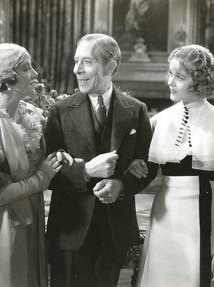
THE KING'S VACATION
US, 1933, 61 minutes, Black and white.
George Arliss, Florence Arliss, Marjorie Gateson, Patricia Ellis, Dudley Digges, Dick Powell.
Directed by John G. Adolfi.
George Arliss won an Academy award for his portrayal of Disraeli, a remake of his silent film, Disraeli, directed by John G. Adolfi. Arliss portrayed a number of historical characters in the 1930s including the Duke of Wellington, Voltaire, Cardinal Richelieu, the Rothschilds.
This is a film which reflects some of the kingdoms in Eastern Europe during the 1930s, revolutions and abdications – and is particularly interesting in retrospect with the abdication of Edward VIII in England.
King Philip came unwillingly to the throne after the deaths of several successors and ruled for 18 years. He is opposed to pomp and finds the daily schedule too demanding. Revolution is in the air, royalty wants to keep its place, he abdicates and goes to live quietly – although there is a delegation to ask him to return. He meets his former love who has had lifelong ambitions to be the Queen and live in extravagant lifestyle. He meets his daughter who is in love with a mechanic, played by Dick Powell in an early role. He also discovers his love for the woman who had been his Queen, very formally, for 18 years.
A very short running time but an engaging performance by George Arliss and interesting in terms of royalty, pomp, abdications.
1. A film of the 1930s, royalty in Europe at the time, revolutions, applications? Looked at in retrospect? Especially the situation in England?
2. Black-and-white photography, the sets of the kingdom, the towns? The musical score? Drink to me only with thine eyes…? The cast?
3. Philip, in himself, unwilling to be King, 18 years, the annulment of his marriage to Helen, the loss of his daughter? Margaret as the Queen? Formal? The style of the Palace, the majordomo, the military, the detailed schedules, the changing uniforms? Seeing the family, so many children? The military inspections? The dedication of the statue? Signing documents – unwillingly? Sending messages for the health of the Queen and their return?
4. His attitude, anti-pomp, liking the people, sympathetic to the revolution?
5. Meeting the public, the assassination attempt, his decision to seek the young man, the discussion, no execution, the man later cheering him on his abdication?
6. On the yacht, with the Margaret, the new home, the reality of his relationship with Margaret, her house, the suggestion that there was Mr X?
7. Meeting Helen again, the 18 year’s absence? Her wanting to be Queen, her lavish lifestyle, fashions? Millie, meeting her father again, her love for John? Her mother’s snobbery, forbidding the relationship with John, the speech and her spurning of mechanics? The plan for the wedding, all her friends and guests, her wanting the tiara, Philip going to the auction? Going to the cottage, her not wanting to revive the past? Her suitor and his leaving? Her lies to Philip?
8. Philip and Millie, going to the garage, finding John, the motor, the discussions about it, Phillip giving advice, supporting the marriage?
9. The delegation to ask him to return to being King, Helen’s great desire to be Queen, his refusal?
10. Going to the auction, the chance encounter with Margaret, returning home, enjoying her company, the discussions, that there was no Mr X? The truth about his love for her?
11. Breaking off with Helen, her having her suitor? His returning to Margaret, and happy ending?
Published in Movie Reviews
Published in
Movie Reviews
Tagged under